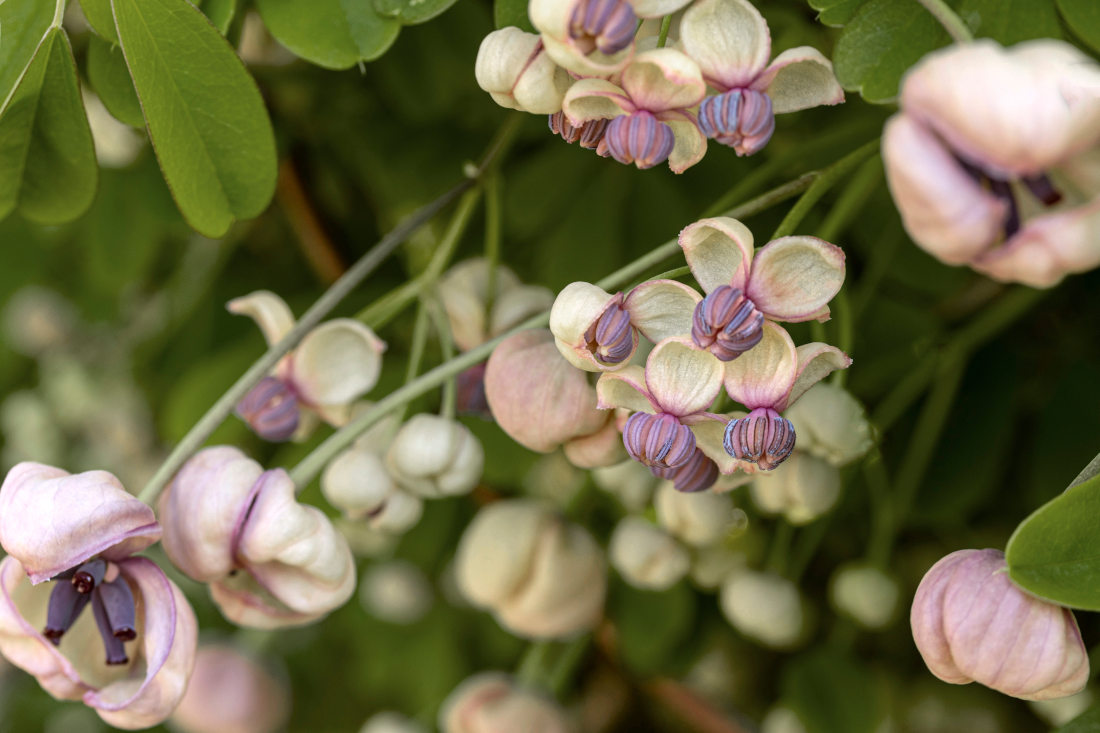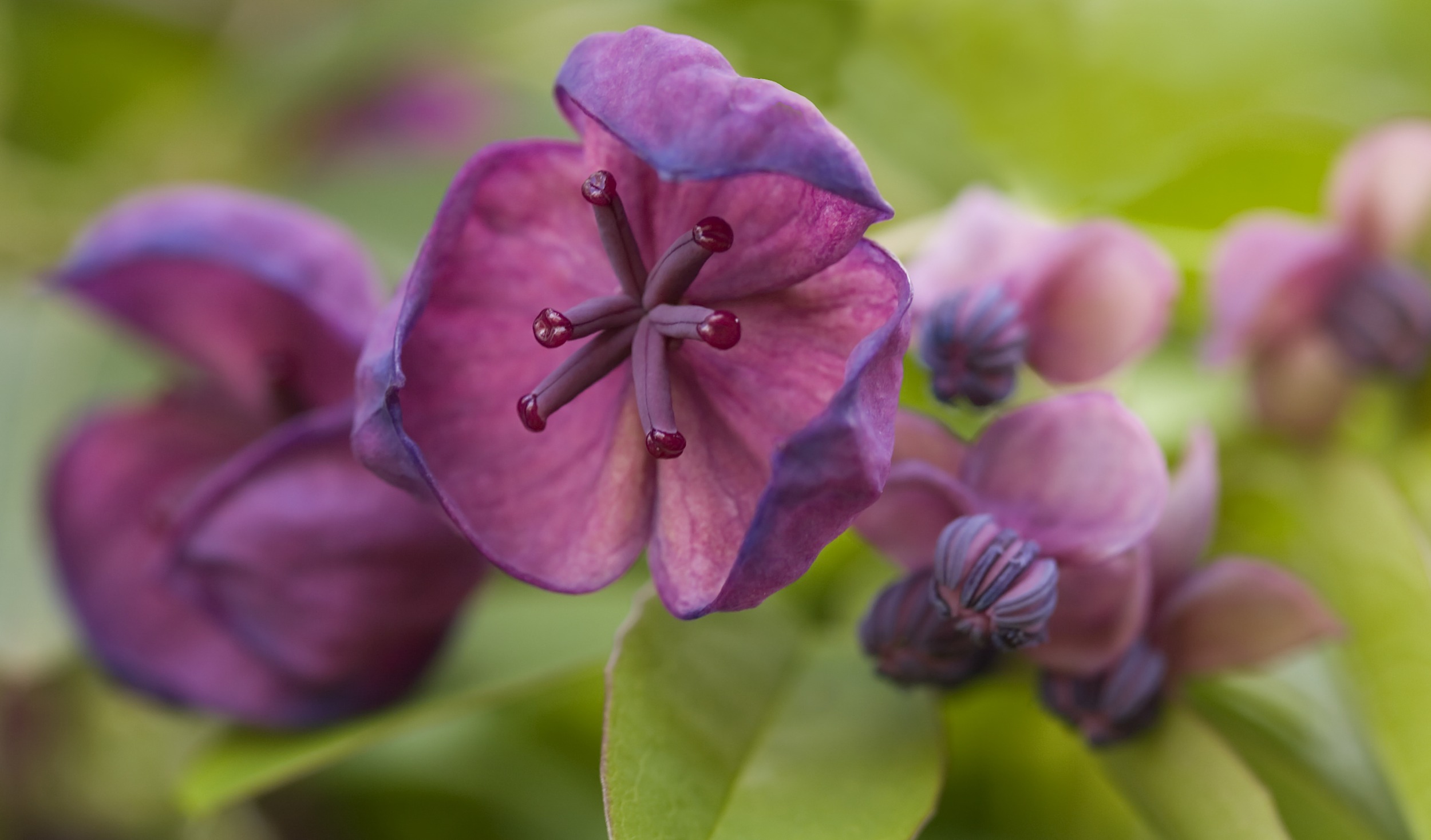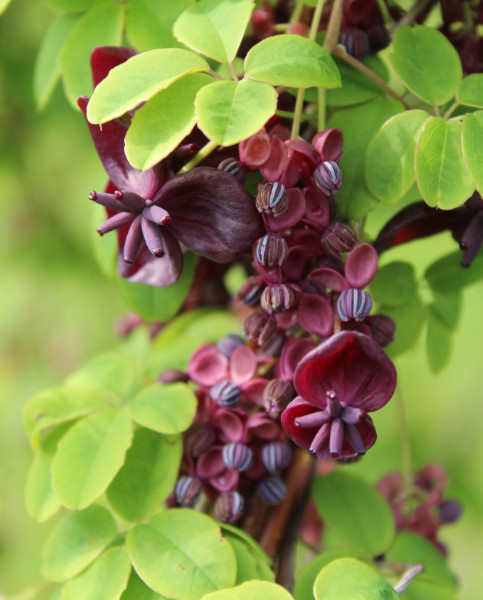How to grow Akebia

Akebia is a genus of about 5 species of unusual, large, twining climbers, all originating from China and Japan. Of these, the most popularly grown is Akebia quinata, remarkable for its peculiar, waxy, chocolate-scented flowers and dangling, sausage-shaped, fleshy, purple fruits. It is evergreen in milder climates, though can be expected to shed some or all its leaves when exposed to strong winds or cold temperatures (this has no lasting impact on the plant).
Akebia is also known by the common name, chocolate vine.
are best planted in a moist, fertile, well-drained soil of chalk, clay, sand or loam within an acidic, alkaline or neutral PH balance. They are best positioned in a sheltered area that receives full sun or part shade. Akebia are well suited to wall side borders in cottage or informal garden settings.
Key Information
Soil pH
Position
Hardiness


Where to plant Akebia
For best results, plant Akebia in autumn or spring, into a moist, fertile, well-drained soil of chalk, clay, sand or loam within an acidic, alkaline or neutral PH balance. They are best positioned in a sheltered area that receives full sun or part shade. Akebia are well suited to wall side borders in cottage or informal garden settings.
An autumn planting can be done by those gardening in mild conditions (and broadly speaking, this is the southern half of the UK). For those liable to cold winters, it is best to wait until spring (generally the northern half of the UK). Planting can also be carried out in summer, though be prepared to water regularly.
Akebia is a fast-growing, vigorous climber which left unchecked can reach up to 10m, though is easily kept smaller with regular pruning (see ‘How to prune akebia’ section below for more information). It can be trained against a wall, or up a large tree or pergola. While the plant itself is fully hardy, a sheltered, warm spot is best for optimal flowering and fruiting.
It is possible to grow akebia in a container, though given its vigorous nature it is likely to need frequent repotting. For best results, grow in the ground.
How to plant Akebia
In the ground
- Clear the chosen area of weeds.
- Dig a planting hole several times larger than the root ball. Now is the time to give your soil a boost by mixing in generous amounts of well-rotted organic matter, and, if it is on the heavy side, some horticultural grit.
- Place the plant in the hole, ensuring the top of the root ball sits level with the surface of the soil. Too low and the plant may rot, too high and the roots can dry out.
- Backfill with soil and firm in gently.
- Soak well with water.
- Mulch with well-rotted organic matter.
In a container
- Choose an appropriate container, ensuring there are plenty of drainage holes in the bottom.
- Use a good quality potting compost with plenty of horticultural grit mixed in, and, if not already present in the compost (check the description on the bag) some slow-release fertiliser granules.
- It can be a good idea to pot up larger containers in situ to save yourself the trouble of moving once full.
- Start by partially filling the pot with compost; enough so that when placed on it the upper surface of the root ball is about 3cm lower than the top of the pot.
- Infill all the space surrounding the root ball with compost, firming down with your fingers then adding a little more so the plant is held tight.
- Pick up the pot (if you can!) and lightly tap on the potting bench or ground a few times to help further settle the compost around the plant.
- Soak well with water.
- A mulch with horticultural grit will look attractive and help to prevent a ‘cap’ or crust forming on the top of the compost (something container plants can suffer due to the artificial nature of their watering).

How to care for Akebia
Pruning and Deadheading
No regular pruning is necessary. However, if you wish to restrict size cut back as much of the longer shoots as required immediately after flowering.
Watering
Water akebia until established (generally throughout the first growing season in the ground), after which it is tolerant of a few days of drought.
Feed with an all-purpose fertiliser to encourage a profuse expanse of blooms and foliage with even better colour.
Cold Protection
Akebia is hardy and able to withstand a UK winter without the need for additional protection, however its flowers may be damaged by a late frost, hence the advice to position it in a warm, sheltered spot.
Pests and Diseases
Akebia tends to be trouble-free.
How to propagate Akebia
Akebia can be propagated by semi-ripe cuttings in summer, using the current year’s growth which by then will be firm and woody at the base while still soft and pliable at the tip.
- Find non-flowered shoots 5-10cm long and snip off the plant.
- Put them in a plastic bag straight away to prevent drying out.
- Fill a container with a compost mix which is at least 50% perlite (or if you prefer, as we do, 100% perlite).
- Trim the end of the cutting to just below a node (point at which leaves grow).
- Remove the lowest third of leaves.
- If the remaining leaves are large, cut them in half with a sharp knife (to reduce water lost through transpiration).
- Insert the cuttings into the compost and water lightly. Several cuttings can be put in the same container if there is enough space to do this without them touching.
- Place in a propagating unit with bottom heat if you have one, or covered with a plastic bag on a windowsill or in a greenhouse if not (out of direct sunlight).
- Keep the cuttings misted and occasionally watered until they root. You will know this has happened when roots emerge out of the bottom of the container.
- Gently remove rooted cuttings and pot them into individual pots. Grow on in a cool yet frost-free environment such as an unheated conservatory, greenhouse, or cold frame, until they are large enough to be planted out.
Common Akebia Questions
- How fast does akebia grow?
Akebia has a fast growth rate and is a speedy solution for covering walls, pergolas, and other supports. It can reach its full size in 5-10 years. - Can I grow akebia in a pot?
The vigorous nature and large eventual size of akebia means it will outgrow even the biggest of pots in a few years. If you are happy to dispose of it and start afresh with a new plant each time this happens, container-growing can work. Otherwise, we advise growing it in the ground.




